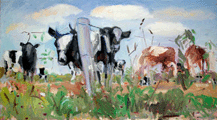
The Artist Statement--
My work seeks a conversation with contemporary art that fits my brand of representational painting. I paint in series and for over 30 years, I seem to drift back and forth between similar themes. Ultimately, I am trying to create the great paintings. Work that transcends the contemporary issues of photography, market, and fashion, and paintings that might have a place in history as a reaction to the “ photographic or a general decorative slickness.” A slickness that I see as not part of the language of painting in which I am involved with. I have an unabashed love with the relationship my work has to history and the unhidden marks my brush makes; the human mark- my marks. I’m interested in making paintings that are personal, solid, and honest. Work that deal with a painted non-photographic space and composition, that embraces the quality of paint and the process.
Always, in the life of a painting, there is an excitement in what that experience allows. The experience of being immersed in the process. For me, it is absolutely not about just recording appearance, but an exploration of the relationships. Composing, exploiting and contorting those relationships and how paint happens to lays down - the surface. In the studio it is battle, or dance or a collision of the accidents. To manipulate and suspend those moments is ultimately how my paintings are constructed. I think about painting in formal compositional terms that relate back to the debt I have, in many ways, to certain Modernist and Abstract Expressionist ideas. I studied in the late 70’s at Stony Brook University with Badelmenti, Perkarsky and the sculpture Robert White and then at Brandeis with Paul Georges. Bobby White, who having studied with Saint-Gaundens, infused in me a sense of lineage among other things. Bobby introduced me to Paul Georges. And thru Georges, it was the eclectic openness of Hoffmann and Leger that would influence and take a life long hold. I was incredibly young and a blank slate. The love I had for Piero, Rembrandt, Titian and “the big boys” was reinforced and validated. I cut my teeth there in the lower east side. Each Friday night I spent at the Figurative Alliance, and afterwards the conversation would continue in some the downtown dive bar, mostly Mare Chiaro on Mulberry Street. Just as many others have said before me, I learnt most of what I know about about art and being an artist - being a painter - from sitting in bars drinking with artists. They were the most committed brilliant painters I ever met. We argued about painting, painters and paintings and I, being real young mostly sat and absorbed. I was spending incredible and immeasurable hours in my studio and in Museums standing in front of Art. Between this and the Education I got from being with real artists I formed my ideas about being a - PAINTER. Whether my work is about some metaphor, idea or a spiritual relationship I have with nature, it is always about painting and paint.
Although I was already exhibiting and felt a part of the New York figurative community, I went to get an MFA at Brooklyn College, when Pearlstein, Bob Henry and Lennart Anderson were there. I had already begun exhibiting in New York, where I had my first solo show at Pene Du Bois Gallery in the East Village. I felt relatively ignored. Except by other artists, all older then I was. They respected me as a - “ a painter’s painter,” with a wild robust energetic attack that set him apart a bit. The scene as I knew it was changing, less cohesive, so
in 1990 I moved my studio to the eastern end of Long Island, Water Mill. I came to the East End for surf, a bigger studio and to escape suburbia, which ultimately seemed to follow me. It was here I became associated with the current Long Island landscape tradition/movement. This happened only after a huge theft from Gotham Fine Arts, what was then my gallery,. It was a loss of about 2 years worth of large figurative and narrative paintings. The gallery closed, the dealer went into hiding and I was left with only small landscapes and still lifes. From these, I was selected to be included as the youngest painter in Ronald G. Pisano’s book, 20th century Long Island Landscape Painting, (New York Graphic Society, Little, Brown Date Published:1990 ) It rather was ironic, this eventual transition from my being a New York painter - making somewhat neo -expressionist figurative paintings, with the landscape as a background, to people thinking of me as a Long Island landscape painter.
But, whether still life, figures or landscapes my work continues to be a search for a personal painting style, one that marries the abstract to the concrete. A still life for example, is often imbed with a personal symbolism and narrative. Not only speaking of the objects, the detritus of life - my life, it speaks to the process and material. A passage of paint, at one time, suggest or rather is - process. The human mark, the brushstroke act as footprint - as well "becomes." It is gesture that breaks the space amongst the flat passages and is left, as a drip, to remind the viewer of the flat - denial of the space still forever just an abstraction. A continual search for a personal iconography, an auto-biographical unembarrassed examination with it’s roots in the history of Art.